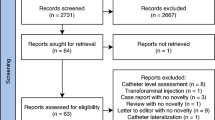Summary
The Plastimed® epidural pressure sensor was evaluated in 35 patients, twenty-eight of whom were suffering from head injury. In seven patients simultaneous intraventricular pressure measurements were obtained. The epidural pressure sensor was only functioning satisfactorily in approximately 2/3 of the patients, while it was malfunctioning or not functioning in the remainder. In seven comparable IVP/EDP studies significant differences up to 25 mm Hg were noted. In three patients IVP was greater than EDP. In two patients the opposite was true. No significant complications were observed.
These unsatisfactory results have made us abandon the technique and resort to intraventricular or subarachnoidal pressure measurements.
Similar content being viewed by others
References
Gjerris F, Børgesen SE, Sørensen SC (1980) Clinical evaluation of a new epidural pressure transducer. In: Shulman K, Marmarou A, Miller JD, Becker DP, Hochwald GM (eds) Intracranial pressure IV. Springer, Berlin Heidelberg New York, pp 386–389
Guggiari M, Bianchi A (1983) Mesure de la pression intracrânienne (PIC). Corrélations entre les pressions obtenues à l'aide d'un capteur extra-dural (PED) et d'un capteur intraventriculaire (PIV). Agressologie (24) 9: 389–390
Guillaume J, Janny P (1951) Manomatrie intracrânienne continue. Intérêt de la méthode et premiers résultats. Rev Neurol 84: 131–142
Hoff J, Barber R (1974) Transcerebral mantle pressure in normal pressure hydrocephalus. Arch Neurol 31: 101–105
Johnston IH, Jennett B (1973) The place of continuous intracranial pressure monitoring in neurosurgical practice. Acta Neurochir (Wien) 29: 53–63
Langfitt TW, Weinstein JD, Kassell NF, Gangliardi LJ (1964) Transmission of increased intracranial pressure. II. Within the supratentorial space. J Neurosurg 21: 998–1005
Lundberg N (1960) Continuous recording and control of ventricular fluid pressure in neurosurgical practice. Acta Psychiatr Neurol Scand [Suppl] (149) 36: 1–193
Rosner MJ, Becker DP (1976) ICP monitoring: Complications and associated factors. Clin Neurosurg 23: 494–519
Sundbärg G, Kjällquist AA Lundberg N, Pontén U (1972) Complication due to prolonged ventricular fluid pressure recording in clinical practice. In: Brock M, Dietz H (eds) Intracranial pressure. Springer, Berlin Heidelberg New York, pp 348–352
Weaver DD, Winn HR, Jane JA (1982) Differential intracranial pressure in patients with unilateral mass lesions. J Neurosurg 56: 660–665
Author information
Authors and Affiliations
Rights and permissions
About this article
Cite this article
Kosteljanetz, M., Børgesen, S.E., Stjernholm, P. et al. Clinical evaluation of a simple epidural pressure sensor. Acta neurochir 83, 108–111 (1986). https://doi.org/10.1007/BF01402387
Issue Date:
DOI: https://doi.org/10.1007/BF01402387




